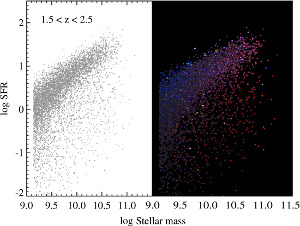False-colour images of the Hubble Ultra Deep Field as predicted by the Millennium Run Observatory (left) and as actually observed by the Hubble Space Telescope (right). The images measure about 5’ by 5’, and were constructed from virtual and real observations through the filters V (blue), i (green), and z (red). The resemblance between the virtual image constructed using the MRObs and the actual image seen by HST is striking. The MRObs images can be analysed in the same way as the real data, with the advantage that only for the MRObs images the underlying “reality” is known. Comparison of these kinds of simulated and real data will allow astronomers to test their methods, test how well the simulations reproduce the actual universe, and make predictions for future observations.

The MRObs observations allow us to visualize the colours, shapes and sizes of galaxies as predicted by the simulations in ways that were previously impossible. In the left panel, galaxies at z~2 are indicated according to their stellar masses and star formation rates (SFR) as predicted by the simulations. In the panel on the right, the same galaxies are plotted, but now they are shown as they would appear in a simulated HST colour-composite image (with the same quality as recent data from the GOODS/ERS programme). The diagram on the right contains a wealth of extra information compared to the standard diagram shown left: The simulated galaxy population at z~2 consists of a blue star-forming sequence as well as a population of massive, red and compact galaxies in which star formation has already shut down, qualitatively similar to observational findings. The MRObs approach has the advantage of allowing astronomers to also quantitatively investigate how the properties of real and simulated galaxies compare.
Cosmological simulations aim to capture our current understanding of galaxy evolution, aid in the interpretation of complex astronomical observations, and make detailed predictions for future experiments. Simulations and observations, however, are often compared in a somewhat indirect way: physical quantities are estimated from the observational data and compared to the models. An important complication with this approach is that observations typically give a highly distorted view of the universe, making the process of extracting physical information a challenge.
Many problems in astrophysics could therefore benefit from doing it the other way round: the entire observing process is applied to the simulations, so that the models can be viewed fully from an observer’s perspective. A small team composed of current and former members of the Max Planck Institute for Astrophysics has now developed the Millennium Run Observatory (MRObs), a theoretical, virtual observatory that uses virtual telescopes to ‘observe’ semi-analytic galaxy distributions based on the MR dark matter simulations developed at MPA. The MRObs produces data that can be processed and analysed using standard observational software packages developed for real observations.
See the website for more details: http://www.mpa-garching.mpg.de/mpa/research/current_research/hl2012-11/hl2012-11-en.html(SY)

